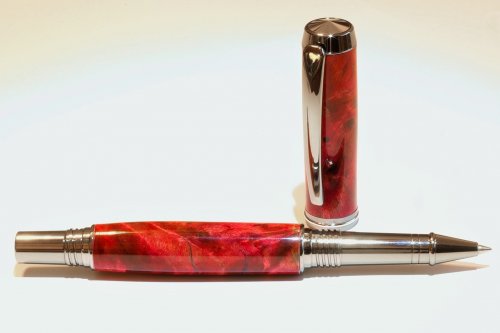rblakemore
Member
...Not ... well, sort of, maybe.
This is a follow up to my thread of 7/25. And, I am also a biologist by education, so I am also a scientist and like lots of experimentation. There are a bunch of pictures attached.
So, I was not satisfied with my first results of blue alumilite dye in stabilizing resin. As soon as I get more Cactus Juice, I will try again.
In the meantime, I have tried using dye directly on the wood, in this case a piece of clear stabilized spalted figured maple. Reading older threads, I chose Jacquard IDye (Jacquard also makes mica dust used in casting and a dye others have used) which I searched for and found at a local JoAnn's Fabrics (a favorite place of my wife). I first mixed with a little bit of 70% Isopropyl Alcohol and it did not mix well at well. Adding water it dissolved quickly. Reading the instructions (sort of recommended), hot water is used. Adding hot water and then soaking the sample blanks, I used a short plastic rod with treated cotton fibers (aka Q-Tip) and coated the two sample blanks; see pictures 1 and 2. The maple looked a dark blue, success, maybe??
When I cut one blank, notice that there was no penetration by the blue dye. See pictures 3 and 4. I went ahead, glued a tube, and turned. The wood was a dingy, gray-blue, not much different than the spalted maple without dye. See picture 5.
I dyed the blank on the lathe sanded and dyed again, and then made a CA finish. See pictures 6 and 7.
And, the final pen is in picture 8. This is a Timberbits Sierra upgrade in Ti and Gold.
I offer this is successful and I achieved a blue, a little dark perhaps; but, this proves that this form of dyeing for coloring blanks does work.
Your thoughts please??
This is a follow up to my thread of 7/25. And, I am also a biologist by education, so I am also a scientist and like lots of experimentation. There are a bunch of pictures attached.
So, I was not satisfied with my first results of blue alumilite dye in stabilizing resin. As soon as I get more Cactus Juice, I will try again.
In the meantime, I have tried using dye directly on the wood, in this case a piece of clear stabilized spalted figured maple. Reading older threads, I chose Jacquard IDye (Jacquard also makes mica dust used in casting and a dye others have used) which I searched for and found at a local JoAnn's Fabrics (a favorite place of my wife). I first mixed with a little bit of 70% Isopropyl Alcohol and it did not mix well at well. Adding water it dissolved quickly. Reading the instructions (sort of recommended), hot water is used. Adding hot water and then soaking the sample blanks, I used a short plastic rod with treated cotton fibers (aka Q-Tip) and coated the two sample blanks; see pictures 1 and 2. The maple looked a dark blue, success, maybe??
When I cut one blank, notice that there was no penetration by the blue dye. See pictures 3 and 4. I went ahead, glued a tube, and turned. The wood was a dingy, gray-blue, not much different than the spalted maple without dye. See picture 5.
I dyed the blank on the lathe sanded and dyed again, and then made a CA finish. See pictures 6 and 7.
And, the final pen is in picture 8. This is a Timberbits Sierra upgrade in Ti and Gold.
I offer this is successful and I achieved a blue, a little dark perhaps; but, this proves that this form of dyeing for coloring blanks does work.
Your thoughts please??
Attachments
-
 9T4A7667_cropped.jpg102.2 KB · Views: 187
9T4A7667_cropped.jpg102.2 KB · Views: 187 -
 9T4A7668_cropped.jpg144.7 KB · Views: 154
9T4A7668_cropped.jpg144.7 KB · Views: 154 -
 9T4A7669_cropped.jpg144.9 KB · Views: 174
9T4A7669_cropped.jpg144.9 KB · Views: 174 -
 9T4A7671_cropped.jpg107.7 KB · Views: 161
9T4A7671_cropped.jpg107.7 KB · Views: 161 -
 9T4A7672_croped.jpg72.4 KB · Views: 170
9T4A7672_croped.jpg72.4 KB · Views: 170 -
 9T4A7673_cropped.jpg71.5 KB · Views: 194
9T4A7673_cropped.jpg71.5 KB · Views: 194 -
 9T4A7674_cropped.jpg48.6 KB · Views: 240
9T4A7674_cropped.jpg48.6 KB · Views: 240 -
 9T4A7682_cropped.jpg115.5 KB · Views: 239
9T4A7682_cropped.jpg115.5 KB · Views: 239




